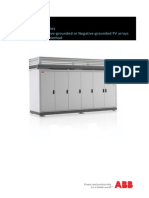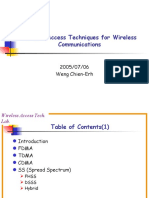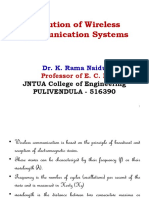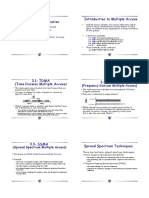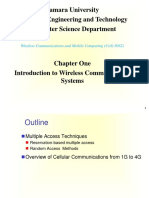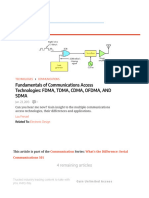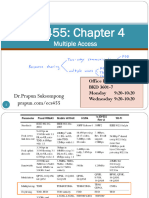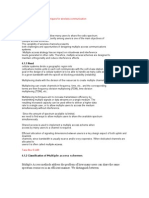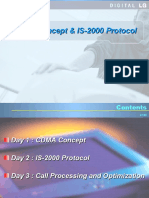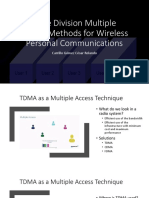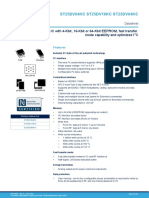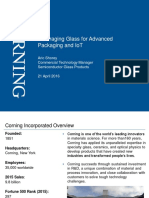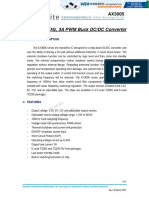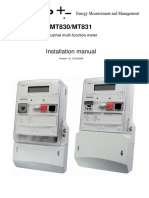Multipleaccess
Multipleaccess
Uploaded by
AdinaOriginal Description:
Copyright
Available Formats
Share this document
Did you find this document useful?
Is this content inappropriate?
Copyright:
Available Formats
Multipleaccess
Multipleaccess
Uploaded by
AdinaCopyright:
Available Formats
GMU - ECE 739, Fall 2003 - Satellite Communications Class: Oct-27-2003
Agenda
• Introduction
ECE 739 – Fall 2003 • Primary multiple access techniques
Satellite Communications – FDMA
– TDMA
Lecture 8 – CDMA
Multiple Access • Hybrid multiple access schemes
Dr. Leila Z. Ribeiro – MF-TDMA and MF-CDMA
October 27, 2003
2
Introduction (1)
• What is multiple access?
Common
Resource
Einführung
• Multiple access is a technique whereby a variable
number of users can access a common resource for the
purpose of communications
4
(C) Leila Z. Ribeiro, 2003 1
GMU - ECE 739, Fall 2003 - Satellite Communications Class: Oct-27-2003
Introduction (2) Introduction (3)
• Where do you find multiple access used? • Why do you need multiple access?
• Multiple access is employed in most wireless
systems, particularly in satellite systems and • Multiple access has many advantages
cellular systems. – Increases efficiency for provider
• The users interface with the common resource (i.e., – Reduces costs to user
the satellite transponder) via an air interface at the – Enhances network control
physical layer
– Enables more flexible designs
• Similar to multiplexing in a wire-line system
5 6
Introduction (8) Introduction (9)
• FDMA
• How do you achieve multiple access? – Band pass filter extracts signal in the correct frequency
slot (band)
• You must be able to separate users from • TDMA
each other inside the common resource – De-multiplexer “grabs” signal in the correct time slot
• Three primary techniques • CDMA
– Direct sequence (DS) or frequency hopped (FH)
– Use a unique frequency (FDMA)
– De-spreader or de-hopper extracts signal with the correct
– Use a unique time slot (TDMA) code
– Use a unique code (CDMA)
7 8
(C) Leila Z. Ribeiro, 2003 2
GMU - ECE 739, Fall 2003 - Satellite Communications Class: Oct-27-2003
Introduction (10): Introduction (11):
Frequency Division Multiple Access (FDMA) Time Division Multiple Access (TDMA)
Amplitude Common resource Amplitude Common resource
User 1 User 2 User 3 User 4 User 1 User 2 User 3 User 4
Frequency Time
Frequency Division Time Division Multiple
Multiple Access (FDMA) Access (TDMA)
•Each user transmits all of the time, but on a different •Each user transmits at the same frequency, but not at the
frequency same time
9 10
Introduction (12): Code Division Multiple Access
Introduction (13)
(CDMA)
Code and
Amplitude Common resource • If the resource (frequency, time, code) is
allocated in advance, it is pre-assigned or fixed
User 4
User 3 multiple access
User 2
User 1 • If the resource is allocated in response to
Time and
Frequency
changing traffic conditions in a dynamic
manner it is demand assigned multiple access
Code Division Multiple (DAMA)
Access (CDMA)
•Each user transmits at the same frequency and time, but with
a different code
11 12
(C) Leila Z. Ribeiro, 2003 3
GMU - ECE 739, Fall 2003 - Satellite Communications Class: Oct-27-2003
FDMA (1)
• Users share the bandwidth (i.e. the frequency available)
within the common resource
– Time is common to all signals
Primary Multiple Access Techniques
• Need to develop a frequency plan, either from user
requests or from market forecasts
• The transponder in the satellite requires a loading plan
to minimize IM products
14
FDMA (2): Transponder Loading Plan Intermodulation Products (1)
Four carriers f1 f2 f3 f4
exist in the
Four medium-sized One large and four amplifier
FM signals small digital signals simultaneously
Amplifier Bandwidth
• IM terms are:
First order terms: f1, f2, f3, and f4
Second order terms: f1 + f2, f1 + f3, f1 + f4, f2 + f3, …
Third order terms: f1 + f2 + f3, f1 + f2 - f3, 2f1 - f2, 2f2 - f1, …
Available transponder bandwidth • Terms falling inside the amplifier bandwidth are important
typically 27 to 72 MHz • Usually, only the odd-order IM products fall within the passband of the
channel. First order terms are the desired signal.
Important to calculate intermodulation (IM) • Amplitude reduces as order rises
products • Most important are third order products (3IM), such as 2fi-fj or fi+fj-fk.
15 16
(C) Leila Z. Ribeiro, 2003 4
GMU - ECE 739, Fall 2003 - Satellite Communications Class: Oct-27-2003
Intermodulation Products (2): Example Intermodulation Products (3): Example (cont.)
• Amplifier bandwidth is from 10 to 11 GHz The two third-order IM products are 10.4 and 10.7 GHz
• Two carriers exist in the amplifier, one at 10.5 GHz and the
other at 10.6 GHz
• At what frequency will the third order intermodulation
product appear at?
We therefore have: Desired signals plus two third-
Answer: order intermodulation products
f1 = 10.5 GHz and f2 = 10.6 GHz
Third-order intermodulation in-band components are:
2f1 - f2 and 2f2 - f1 10.0 10.2 10.4 10.6 10.8 11.0 GHz
= (2 x 10.5 – 10.6) and (2 x 10.6 – 10.5)
= 10.4 GHz and 10.7 GHz
Why is this a problem?
17 18
Intermodulation Products (4): Example (cont.) Intermodulation Products (5)
• IM can cause in-band interference
• If a new user now accesses the amplifier at • Extremely important to calculate where
10.4 or 10.7 GHz, the new signals fall right intermodulation products will fall
on top of the intermodulation signals
Intermodulation signals New signals passing • Avoid regularly spaced carrier signals
interfere with the new through the amplifier
signals
• Satellite systems have very complicated
10.0 10.2 10.4 10.6 10.8 11.0 GHz software to calculate IM products
19 20
(C) Leila Z. Ribeiro, 2003 5
GMU - ECE 739, Fall 2003 - Satellite Communications Class: Oct-27-2003
Intermodulation Products (7) Amplifiers (1)
60 W
• IM products become more severe as an
amplifier becomes non-linear
50
Output back-off
Output signal power
• To achieve linearity, amplifiers should not
40
be run at their maximum rated power
30
Input back-off
• Reducing the output power increases life
20 10
• Process is called backing off an amplifier
0
0 10 20 30 40 50 60 70 80 90 100 mW
Input signal power
21 22
Amplifiers (2) Amplifiers (3)
60 W
• Manufacturers usually specify Saturated output power of 55 W
– Saturated output power
50
1 dB compression occurs at an output power of 46 W
Output signal power
• This is the maximum output power possible without
40
damaging the amplifier /36
00
5,0
of2
– Small signal gain 30 in
ga dB
ar .4 Saturated output power: 55 W
line 28
• This is the gain of the amplifier when it is operating in to 4 ⇒
a
ds 94.4 Small signal gain: 28.4 dB
20
on
its linear region sp = 6
C or
re 1 dB compression point: 46 W
10
– 1 dB compression point
• This is the point 1 dB down from the linear gain line
0
0 10 20 30 40 50 60 70 80 90 100 110 mW
Input signal power
23 24
(C) Leila Z. Ribeiro, 2003 6
GMU - ECE 739, Fall 2003 - Satellite Communications Class: Oct-27-2003
Amplifiers (4) Amplifiers (5): Multi-Carrier Example
• As in the previous example, care must be taken when • Amplifier has linear output power of 50 W,
interpreting the stated characteristics and bandwidth of 50 MHz
• Summary: • Two signals, occupying 20 MHz and the
– For 55 W maximum power read 46 W other 30 MHz
– For linear gain read 35 W maximum output power • Find: Output power of each of the signals?
– If there is more than one carrier, power is divided up as
ratio of occupied bandwidth • Answer:
– The 30 MHz signal uses 30 W
– The 20 MHz signal uses 20 W
25 26
FDMA Advantages FDMA Disadvantages
• IM can cause C/N to fall
• Simplest to implement
• Back-off needed to reduce IM
• Generally less supervisory control required
• Parts of band cannot be used because of IM
• Can achieve lowest bandwidth and power
requirements • Transponder power is shared amongst carriers
• Cheapest • Power balancing must be done carefully
• Quickest customer acceptance • Frequencies get tied to routes
27 28
(C) Leila Z. Ribeiro, 2003 7
GMU - ECE 739, Fall 2003 - Satellite Communications Class: Oct-27-2003
TDMA (1) TDMA (2): Burst Time Plan
• Users share the time • TDMA plans first organize the users into a
– Frequency is common to all signals common frame structure
• Develop a burst time plan from user capacity • Frame is fixed length in time
requests • Receiver information required to detect start
of the frame
• Large system burst time plans can be
complicated and difficult to change Frame 1 Frame 2 Frame 3 Frame n
Header gives timing reference and
Frame length payload information
29 30
TDMA (3): Burst Time Plan (cont.) TDMA (4): Burst Time Plan (cont.)
• Frame is not completely filled (as it is in TDM)
User #1 #2 #3 #N
• Guard bands are left between each payload
element and traffic is organized into a set
sequence – the burst time plan Frame Time for Burst Time Plan time
•Users occupy a set portion of the frame
• Every user must be synchronized in time
according to the burst time plan
•Note:
• Timing is crucial – Guard band times between bursts
31 32
(C) Leila Z. Ribeiro, 2003 8
GMU - ECE 739, Fall 2003 - Satellite Communications Class: Oct-27-2003
TDMA (5): Schematic TDMA (6)
• Frame header contains control information
• Preamble in each traffic burst provides
User 1 synchronization information
User 2 • Minimum frame length is 125 µs
– 125 µs ≡ 1 voice channel sampled at 8 kHz
• Maximum frame length is determined by traffic and
User 3 system requirements
Frame length • Examples
(in time)
– 2 ms for INTELSAT, 120 Mbps TDMA
User 4
Frame consists of four payload pulses – 90 ms for Iridium
33 34
TDMA (7): Synchronization TDMA (8): Example
• Transponder bandwidth = 36 MHz
• Best if range between user and common resource is • Bit rate (QPSK) 60 Mbps = 60 bits/µs
accurately known at all times • Four stations share transponder in TDMA, each
using 125 µs frames
• Distance between users and common resource varies • Preamble = 240 bits
continuously • Guard time = 1.6 µs
• Find:
– (a) Transponder capacity in terms of 64 kbps speech
• User and common resource must monitor position of channels?
burst within the frame at all times – (b) How many channels can each earth station transmit?
35 36
(C) Leila Z. Ribeiro, 2003 9
GMU - ECE 739, Fall 2003 - Satellite Communications Class: Oct-27-2003
TDMA (9): Example (cont.) TDMA (10): Example (cont.)
FRAME Solution:
= 125 µs There are four earth stations transmitting within the 125 µs
frame, so
#1 #2 #3 #4
• 125 = (4×4 µs) + (4×1.6 µs) + (4×T µs)
T • Or T = (125 – 16 – 6.4)/4 = 25.65 µs is the period of data
Guard time transmission for each earth station per frame.
96 bits = 1.6 µs
• 60 Mbit/s ≡ 60 bits/µs, thus 25.65 µs => N = 1539 bits per earth
station per frame.
Traffic: N bits • 1 frame is sent every 125 µs, I.e., 8000 frames are sent per
let it = T µs second.
• Voice channels: 8000 words per second, 8 bits per word.
Pre-amble 240 bits • 1539 bits/(8 bits/word) = 192 words/frame/earth station
= 4 µs @ 60 bits/ µs = 192 voice channels/earth station
37 38
TDMA (11): Example (cont.) TDMA Advantages
– (a) What is the transponder capacity in terms of • No intermodulation products (if full
64 kbit/s speech channels? bandwidth of the common resource is
occupied)
Answer: 4 x 192 = 768 voice channels
– (b) How many channels can each earth station • Saturated transponder operation possible
transmit?
• A flexible burst time plan optimizes
Answer: 192 voice channels (users per frame) capacity per connection
39 40
(C) Leila Z. Ribeiro, 2003 10
GMU - ECE 739, Fall 2003 - Satellite Communications Class: Oct-27-2003
TDMA Disadvantages CDMA (1)
• Complex
• Signals share both time and frequency
– Separation of signals is through the use of unique codes
• Each user must transmit at a common burst rate that (technically, they are mutually orthogonal)
is much higher than user’s required rate
• Each user is assigned a spreading code
• Must stay in synchronization – Station 1 ⇒ code 1
– Station 2 ⇒ code 2
• Requires complicated channel equalization in
mobile systems • Code rate (or chip rate) >> data rate
41 42
CDMA (2) CDMA (3)
• Spreading means the information bits are
• Can be done with spreading or hopping spread amongst a huge number of code bits
codes
• Code sequence (at the chip rate) is mixed
with the information sequence (at the
• CDMA is a solution for severe interference information rate) to provide a spread signal
environments, usually at a capacity loss Narrow-band
Mixer
Wide-band, spread
compared with TDMA and FDMA source information (spectrum) signal
This is Direct Sequence
Wide-band code generator Spread Spectrum (DSSS)
43 44
(C) Leila Z. Ribeiro, 2003 11
GMU - ECE 739, Fall 2003 - Satellite Communications Class: Oct-27-2003
CDMA (4) CDMA (5): DSSS/FHSS Hybrid
• Hopping means the frequencies that are sent Mixer Relatively
‘hop’ randomly amongst a large set of Low data rate
narrow-band
DSSS Here we have a narrow-
frequencies => ‘spread’ signal baseband source
information
band DSSS signal used as
the basis for a FHSS signal
• Similar to BFSK, except the logical 1 and Narrow-band Code
generator
logical 0 frequencies change
Set of frequencies for Possible
logical 1 pairs Set of frequencies for Possible
Frequency
of Frequency logical 1 pairs
Hopping code
Narrow-band hopped Hopping code of
generator Set of frequencies for
source frequencies generator hopped
logical 0 Set of frequencies for
information frequencies
logical 0
This is Frequency Hopped
Spread Spectrum (FHSS)
45 46
CDMA (6): DSSS CDMA (7): DSSS Generation
Outgoing spread
• As noted before: All users share the same Incoming bit
stream
bit stream
time and frequency +1 t
mixer +1 +1 +1 +1 +1 +1 +1
t
-1
• Signals are separated by using a unique -1 -1 -1 -1 -1 -1 -1
(mutually orthogonal) code
– Codes must be “orthogonal” so that user A does
not respond to a code intended for user B +1 +1 +1 +1 +1 +1 +1 +1
t
– Codes are usually very long : PN sequence, Each incoming bit -1 -1 -1 -1 -1 -1
is multiplied by
gold, or Kasami codes the PN sequence
Spreading PN sequence
47 48
(C) Leila Z. Ribeiro, 2003 12
GMU - ECE 739, Fall 2003 - Satellite Communications Class: Oct-27-2003
CDMA (8): DSSS Receiver CDMA (9): DSSS Spectrum
Incoming DSSS Recovered bit
bit stream stream
+1 +1 +1 +1 +1 +1 +1 mixer +1 +1 +1 +1 +1 +1 +1
t t
f
-1 -1 -1 -1 -1 -1 -1 -1 -1 -1 -1 -1 -1 -1 Narrow-band data “spread”
Narrow-band data over the full bandwidth
+1 +1 +1 +1 +1 +1 +1 +1
t De-Spreading
Each incoming bit -1 -1 -1 -1 -1 -1 Sequence Other spread signals added, De-spreading process brings the
is multiplied by filling up the channel with wanted channel out of the noise
the PN sequence De-Spreading PN sequence many noise-like signals
49 50
CDMA (10): DSSS Spectrum (cont.) CDMA (11): Applications
Other users in channel just look like noise
• Military
• Flat - usually below the noise – Anti-jam (AJ)
• Code must be compressed (de-spread) to – Low probability of intercept (LPI)
raise the signal above the noise
• Receiver must synchronize to a code • Commercial
sequence which is below the noise – VSATs (due to wide beams)
– GPS
• Requires the use of a generator and
– Microwave cellular systems (IS-95, IS-95B, IS-2000,
correlator WCDMA)
51 52
(C) Leila Z. Ribeiro, 2003 13
GMU - ECE 739, Fall 2003 - Satellite Communications Class: Oct-27-2003
Hybrid Multiple Access Schemes (1)
• It is rare for a non-video traffic stream to occupy a
single transponder fully
– Most large data and voice traffic streams have migrated
Hybrid Multiple Access Schemes to fiber-optic cables
– Multiple access generally implies multi-point to multi-
point, rather than point-to-point
• Smaller traffic streams enter the transponder under
hybrid access schemes
54
Hybrid Multiple Access Schemes (5):
Hybrid Multiple Access Schemes (2)
MF-CDMA
• Transponder is divided up into smaller • MF-CDMA operates in a similar manner to
bandwidth segments (as in FDMA) MF-TDMA
• Smaller segments are occupied with traffic – Transponder divided up in FDMA fashion
streams that can be TDMA or CDMA – Instead of narrow-band TDMA channels in the
FDMA slots, narrow-band CDMA channels
• These access schemes are generally called
occupy the FDMA slots
multi-frequency TDMA and CDMA, or
MF-TDMA and MF-CDMA • Similar advantages and disadvantages as
with MF-TDMA
55 56
(C) Leila Z. Ribeiro, 2003 14
You might also like
- ICT - Question Bank (Basic Computer)Document3 pagesICT - Question Bank (Basic Computer)Shafeek Ghreeb88% (25)
- EA900II Maintenance Manual 1 - 3KVA PDFDocument66 pagesEA900II Maintenance Manual 1 - 3KVA PDFVictor Mihai Oglinda Elivic70% (10)
- Ansi TiaDocument3 pagesAnsi TiaFritzie Luayon0% (1)
- GroundingDocument16 pagesGroundingEdmundo Lopes100% (1)
- Defcon 20 Lee NFC HackingDocument24 pagesDefcon 20 Lee NFC HackingMardiant DjokovicNoch keine Bewertungen
- Bruno Clerckx SlidesDocument60 pagesBruno Clerckx SlidesMehrdad SalNoch keine Bewertungen
- Topic 3 Satellite Communication SystemDocument77 pagesTopic 3 Satellite Communication SystemValarmathi Selvarajoo50% (2)
- Chapter 5 - 55multiple Access TechniquesDocument34 pagesChapter 5 - 55multiple Access Techniquesnesredinshussen36Noch keine Bewertungen
- Multiple Access Techniques For Wireless CommunicationsDocument67 pagesMultiple Access Techniques For Wireless CommunicationsVarsha JanardhananNoch keine Bewertungen
- Module 3 - Equalization Techniques Multiplexing and Multi-User AccessDocument33 pagesModule 3 - Equalization Techniques Multiplexing and Multi-User AccesstejasdruvakumarNoch keine Bewertungen
- Multiple Access Techniques For Wireless Communications: 2005/07/06 Weng Chien-ErhDocument60 pagesMultiple Access Techniques For Wireless Communications: 2005/07/06 Weng Chien-ErhVijay BabuNoch keine Bewertungen
- Unit 4: Multiplexing and Multi-User AccessDocument44 pagesUnit 4: Multiplexing and Multi-User AccessdfbbvcxNoch keine Bewertungen
- 5.0 Multiple Access Edited - 22102019Document61 pages5.0 Multiple Access Edited - 22102019kalsiumbikarbon4493Noch keine Bewertungen
- Dep50063 - Topik 5 - PolimsiaDocument61 pagesDep50063 - Topik 5 - PolimsiaBewNoch keine Bewertungen
- Chapter 5Document24 pagesChapter 5Alexander VoltaNoch keine Bewertungen
- Mutiple Access Ver2Document36 pagesMutiple Access Ver2AmrAraagNoch keine Bewertungen
- Chapter 8 - Multiple Access TechniquesDocument30 pagesChapter 8 - Multiple Access TechniquesDr. Mudita JunejaNoch keine Bewertungen
- Wireless and CELLULAR COMMUNICATION (18EC81) Module-5Document52 pagesWireless and CELLULAR COMMUNICATION (18EC81) Module-51DT18EC106 Y SAI MEGHANANoch keine Bewertungen
- Chapter 6 Multiple AccessDocument49 pagesChapter 6 Multiple AccessYohannes NakachewNoch keine Bewertungen
- Evolution of Wireless Communication Systems: Dr. K. Rama NaiduDocument114 pagesEvolution of Wireless Communication Systems: Dr. K. Rama NaidusivakumarNoch keine Bewertungen
- C4 Mac PDFDocument6 pagesC4 Mac PDFNazar AzizNoch keine Bewertungen
- Generation of Interleaver For IDMADocument4 pagesGeneration of Interleaver For IDMADuy Đinh Nguyễn NhấtNoch keine Bewertungen
- 08 Multiplexing PDFDocument27 pages08 Multiplexing PDFShivaji SinhaNoch keine Bewertungen
- Wireless Communication Chapter 2Document30 pagesWireless Communication Chapter 2Silabat AshagrieNoch keine Bewertungen
- Orthogonal Frequency Division Multiple Access: Ofdma)Document13 pagesOrthogonal Frequency Division Multiple Access: Ofdma)tamtaNoch keine Bewertungen
- Channelization Protocols - StudytonightDocument9 pagesChannelization Protocols - StudytonightJajam Nagaraju 20PHD7137Noch keine Bewertungen
- Presentation MultiplexingDocument15 pagesPresentation MultiplexingShuvro DasNoch keine Bewertungen
- Samara University College of Engineering and Technology Computer Science DepartmentDocument26 pagesSamara University College of Engineering and Technology Computer Science DepartmentTeze TadeNoch keine Bewertungen
- CDMAMobileTechnologyOverview PDFDocument49 pagesCDMAMobileTechnologyOverview PDFmau_mmx5738Noch keine Bewertungen
- Ec6651 Communication Engineering Unit 4Document36 pagesEc6651 Communication Engineering Unit 4Anonymous Ndsvh2soNoch keine Bewertungen
- Part7 - Duplexing and Multiple Access TechniquesDocument25 pagesPart7 - Duplexing and Multiple Access TechniquesSeegah JoNoch keine Bewertungen
- Lec 3Document56 pagesLec 3Bilal RasoolNoch keine Bewertungen
- Pattern Division Multiple Access (PDMA) - A Novel Non-Orthogonal Multiple Access For 5G Radio NetworksDocument12 pagesPattern Division Multiple Access (PDMA) - A Novel Non-Orthogonal Multiple Access For 5G Radio Networksletthereberock448Noch keine Bewertungen
- Multipal AccessDocument3 pagesMultipal Accessचौकीदार गोपाल भार्गवNoch keine Bewertungen
- Sdma - Tdma - Fdma - Cdma.Document11 pagesSdma - Tdma - Fdma - Cdma.julie MNoch keine Bewertungen
- ECS455 - 4-6 - AllDocument246 pagesECS455 - 4-6 - AllAmmar IkramNoch keine Bewertungen
- Lecture4 CS169Document41 pagesLecture4 CS169Maryam RahimluNoch keine Bewertungen
- Chapter 3 - Wireless CommunicationDocument32 pagesChapter 3 - Wireless CommunicationMuhammad Abd JalilNoch keine Bewertungen
- Multiple Access Tech and DS CDMA 03 Feb 23Document154 pagesMultiple Access Tech and DS CDMA 03 Feb 23Tanmoy PandeyNoch keine Bewertungen
- Multiple Access TechniquesDocument50 pagesMultiple Access TechniquesHarsha BomannaNoch keine Bewertungen
- Multiplexing: Principles of Communication Systems (PCS) EEE 351Document15 pagesMultiplexing: Principles of Communication Systems (PCS) EEE 351nabeel hasanNoch keine Bewertungen
- CH 4 Multiple Access Techniques For Wireless Communication Start of ChapterDocument4 pagesCH 4 Multiple Access Techniques For Wireless Communication Start of ChapterkdtkopNoch keine Bewertungen
- Multiple Access Techniques For Wireless CommunicationsDocument60 pagesMultiple Access Techniques For Wireless CommunicationsAllanki Sanyasi RaoNoch keine Bewertungen
- MADocument94 pagesMAloginmadeshwarNoch keine Bewertungen
- CDMA TextDocument7 pagesCDMA TextNriman ShehadehNoch keine Bewertungen
- CD MaDocument24 pagesCD Masubhra.ray83Noch keine Bewertungen
- Assignment#3: Name: Muhammad Qasim Reg# Sp17-BCS-047 Submitted To: DR - Salman Iqbal Subject: Wireless NetwokDocument4 pagesAssignment#3: Name: Muhammad Qasim Reg# Sp17-BCS-047 Submitted To: DR - Salman Iqbal Subject: Wireless NetwokQasim CheemaNoch keine Bewertungen
- LTE Basics Physical LayerDocument62 pagesLTE Basics Physical LayersaeedfsaeedNoch keine Bewertungen
- Chapter 4Document2 pagesChapter 4Lin ZawNoch keine Bewertungen
- Cdma Concept Presentation-08Document187 pagesCdma Concept Presentation-08aman_delhiboyNoch keine Bewertungen
- UNIK4230: Mobile Communications: Abul KaosherDocument47 pagesUNIK4230: Mobile Communications: Abul KaosherZander ZanNoch keine Bewertungen
- Cdma-Basic PrincipleDocument35 pagesCdma-Basic Principlemohamed ameeNoch keine Bewertungen
- 8264 - 05-Satellite Multiple AccessDocument24 pages8264 - 05-Satellite Multiple AccessJoshua Arya Gangga GNoch keine Bewertungen
- Network Access MethodsDocument9 pagesNetwork Access MethodsKOMERTDFDFNoch keine Bewertungen
- Department of Electronics & Communication Engineering: Satish Kanapala, Assistant ProfessorDocument43 pagesDepartment of Electronics & Communication Engineering: Satish Kanapala, Assistant ProfessorKvnsumeshChandraNoch keine Bewertungen
- Unit-4 Mutiple Access WCDocument63 pagesUnit-4 Mutiple Access WCKothari SurajNoch keine Bewertungen
- Time Division Multiple Access Methods For Wireless Personal CommunicationsDocument16 pagesTime Division Multiple Access Methods For Wireless Personal CommunicationsCesar CarrilloNoch keine Bewertungen
- T Ofdm-Idma A W C S: HE Pproach To Ireless Ommunication YstemsDocument7 pagesT Ofdm-Idma A W C S: HE Pproach To Ireless Ommunication YstemsannaNoch keine Bewertungen
- Wireless Technology - BasicsDocument68 pagesWireless Technology - Basicsparon96766Noch keine Bewertungen
- Wireless - 4.1 (CDMA)Document74 pagesWireless - 4.1 (CDMA)api-3856938Noch keine Bewertungen
- Fundamentals of CDMADocument53 pagesFundamentals of CDMANehal SharmaNoch keine Bewertungen
- Adapted From T.S. Rappaport's Wireless Communications Multiple Access Techniques For Wireless CommunicationsDocument70 pagesAdapted From T.S. Rappaport's Wireless Communications Multiple Access Techniques For Wireless CommunicationsMeera NairNoch keine Bewertungen
- Fdma NoteDocument21 pagesFdma Noteggi2020.1940Noch keine Bewertungen
- Digital Audio Broadcasting: Principles and Applications of Digital RadioFrom EverandDigital Audio Broadcasting: Principles and Applications of Digital RadioWolfgang HoegNoch keine Bewertungen
- Multi-Carrier and Spread Spectrum Systems: From OFDM and MC-CDMA to LTE and WiMAXFrom EverandMulti-Carrier and Spread Spectrum Systems: From OFDM and MC-CDMA to LTE and WiMAXNoch keine Bewertungen
- ManholeMonitorPlusManual 2108 SMDocument32 pagesManholeMonitorPlusManual 2108 SMTri NguyenNoch keine Bewertungen
- Assignment-6question and SolutionDocument10 pagesAssignment-6question and SolutionMaulinduNoch keine Bewertungen
- ST 25 DV 04 KCDocument203 pagesST 25 DV 04 KCPista KissNoch keine Bewertungen
- ECEN 214 Lab 7Document7 pagesECEN 214 Lab 7Shoaib AhmedNoch keine Bewertungen
- MW5360 4G LteDocument4 pagesMW5360 4G LteManos MehedeeNoch keine Bewertungen
- IMAPs - Corning Overview - 4-21-16 FINALpptxDocument28 pagesIMAPs - Corning Overview - 4-21-16 FINALpptxNadia PutriNoch keine Bewertungen
- Pc-Alpha Datasheet Iec enDocument2 pagesPc-Alpha Datasheet Iec enTR JJNoch keine Bewertungen
- NotificationDocument2 pagesNotificationniranjan342Noch keine Bewertungen
- 5 Pen PC Technology PDFDocument8 pages5 Pen PC Technology PDFNikitha ReddyNoch keine Bewertungen
- Datasheet Andrew Antenna 7.3m C Band ES73 1Document14 pagesDatasheet Andrew Antenna 7.3m C Band ES73 1AmjadNoch keine Bewertungen
- AX3005 AXEliteDocument11 pagesAX3005 AXElitebibib bibibNoch keine Bewertungen
- PT 1728Q Advantage Parts Manual 3 Electronics Cabinet SectionDocument16 pagesPT 1728Q Advantage Parts Manual 3 Electronics Cabinet SectionBrandon CatronNoch keine Bewertungen
- General Description: High-Speed CAN Transceiver With Standby ModeDocument27 pagesGeneral Description: High-Speed CAN Transceiver With Standby ModeAT VSNoch keine Bewertungen
- COST 288 Nanoscale and Ultrafast PhotonicsDocument145 pagesCOST 288 Nanoscale and Ultrafast Photonicsma860930Noch keine Bewertungen
- DatasheetDocument5 pagesDatasheetanggaNoch keine Bewertungen
- Wiring Diagram IZMX PXRDocument20 pagesWiring Diagram IZMX PXRThiago SilvaNoch keine Bewertungen
- Bus Bus BusDocument4 pagesBus Bus BusNileshNoch keine Bewertungen
- CatalogDocument6 pagesCatalogamirNoch keine Bewertungen
- STM 32 G 061 C 6Document126 pagesSTM 32 G 061 C 6AlexNoch keine Bewertungen
- Spice RefDocument14 pagesSpice RefJohn Adriel GuintoNoch keine Bewertungen
- STLD BITS With AnswersDocument4 pagesSTLD BITS With AnswersRahul Mishra33% (3)
- Stepper Motor DriverDocument26 pagesStepper Motor DriverKiran ZoroNoch keine Bewertungen
- MT831 Installation ManualDocument92 pagesMT831 Installation ManualmamijatoNoch keine Bewertungen
- FL-0254 - A OperationDocument2 pagesFL-0254 - A OperationJesus David Gonzalez100% (1)
- Dac60000 6u InvertersDocument4 pagesDac60000 6u InvertersKopo EdwardNoch keine Bewertungen



